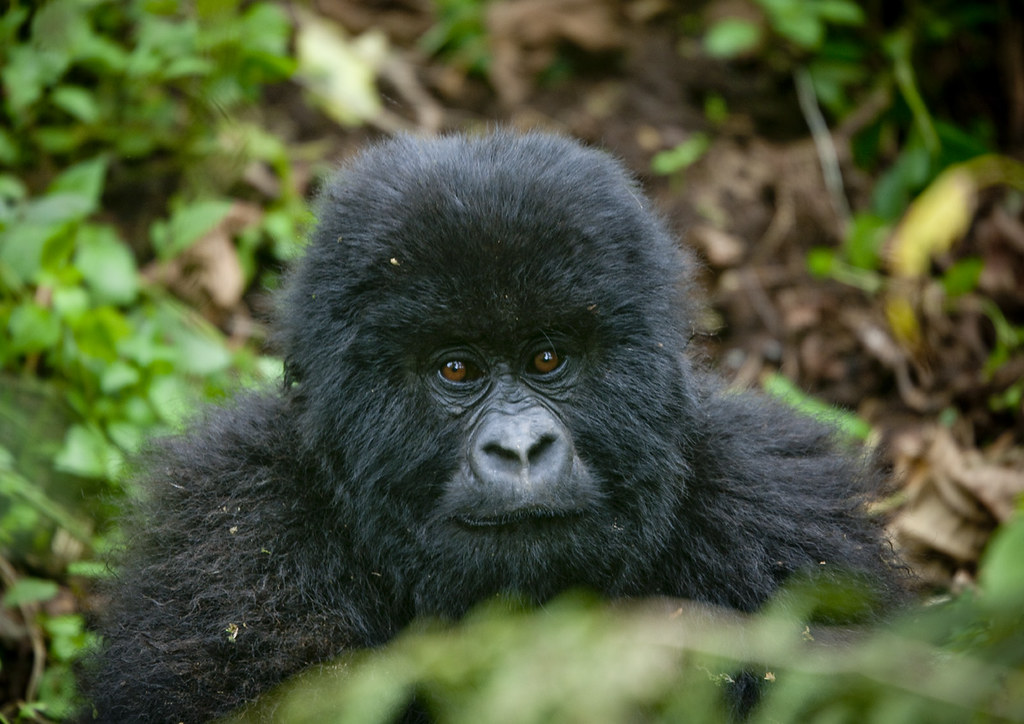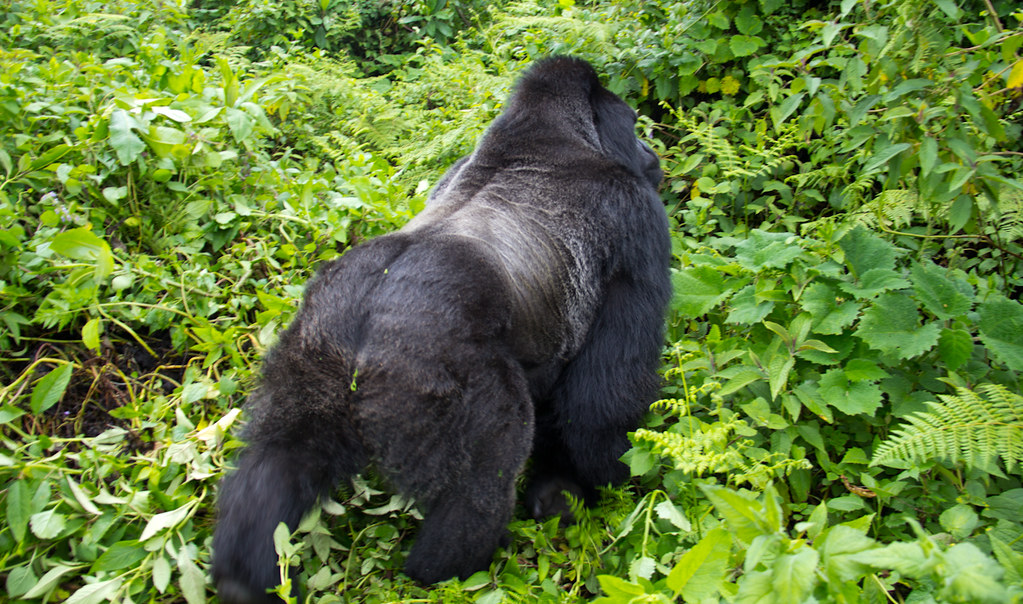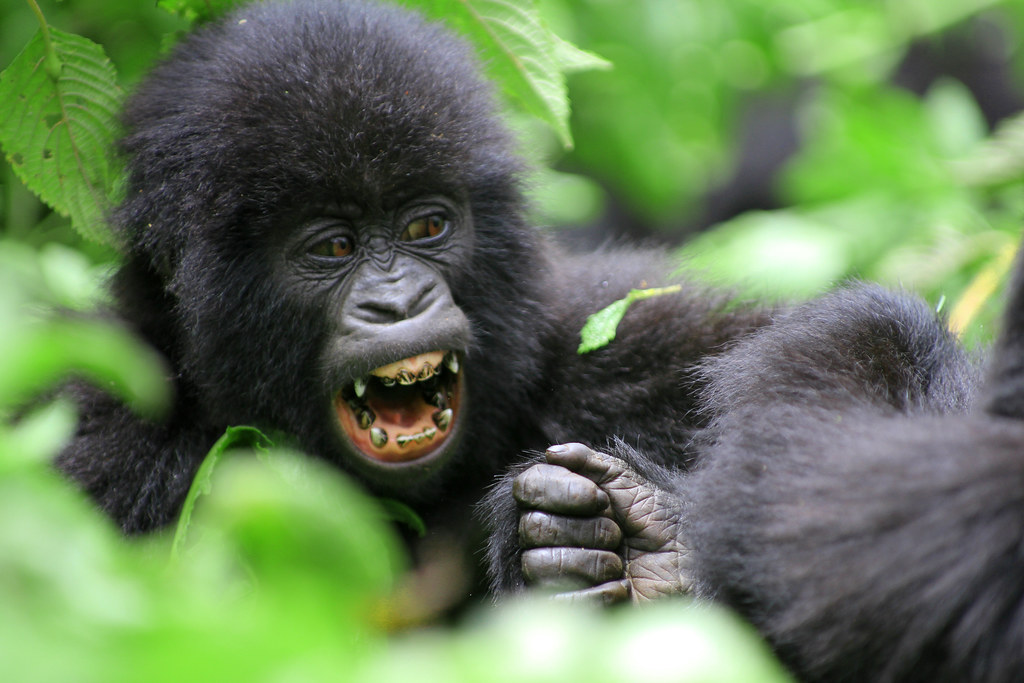Gorilla Trekking in Rwanda (Volcanoes National Park)
Gorilla Trekking in Rwanda: an exceptional tourism activity in the Land of a Thousand Hills. It is not a surprise when one chooses to visit Rwanda for the remarkable gorilla trekking experience. Rwanda is one of three African countries known for housing the world’s remaining mountain gorilla population. As their name states, mountain gorillas are sub subspecies of the eastern gorillas (gorilla beringei beringei). They are considered endangered species, and they are commonly sighted in elevations of 8000 to 13000 feet. They are the largest apes on earth, weighing between 135 – 220 kilograms, size 1-2 meters tall, and their general life span is 40- 50 years. Mountain gorillas are muscular apes with a massive chest, broad hands and feet, shorter arms, and long, thick hair. These incredible primates live in groups called families led by a dominant silverback male. They are an important part of the environment because they are herbivores and graze on large areas of vegetation. If there were no mountain gorillas, the food chain in their area would have an imbalance, something bad for the Earth.
Where to trek gorillas in Rwanda
Gorilla trekking in Rwanda is mainly done in the Volcanoes National Park, which is considered the best place to see mountain gorillas in Africa. Other mountain gorillas are found in Bwindi Impenetrable Park, Mgahinga National Park in Uganda, and Virunga National Park in the Democratic Republic of Congo. Volcanoes National Park lies in the northwestern part of Rwanda, covering over 16000 hectares. The park comprises Afromontane forests, savanna grasslands, bamboo forested zones, and large swamps, all distributed along the five Virunga volcanoes they are Mount Karisimbi, Sabinyo, Bisoke, Gahinga, and Muhabura.
Mountain gorillas are found in this park with other wildlife including golden monkeys, bush elephants, hyenas, buffalos, duikers, bushbucks, and many other mammals. Many plant species and birds can be spotted on a visit to the park.
The gorilla trekking experience
Many tourists are drawn to Rwanda’s Volcanoes National Park for gorilla tourism, because of the high chances of sighting mountain gorillas. In the Volcanoes National Park, gorilla tracking involves traversing steep mountain slopes and dense bamboo woodlands in search for a particular gorilla family. Rwanda has 10 gorilla families ready for daily tracking, and the other 2 are set aside for research purposes.
What to do on the actual trekking day.
In the early morning of your tracking day, carry your passport, gorilla trekking permit, trekking gear, and packed snacks, and head to the park headquarters in Kinigi. You will be taken through a briefing about the dos and don’ts of the activity. The passports will be verified and permits checked to prove ownership and other necessary details.
You will be served with a hot cup of tea as you are entertained by traditional dancers to get you set for the trek. You will be grouped into groups of 8 people, provided with walking sticks ( if you need it), and allocated to a specific gorilla family. Assigning to the gorilla family depends on fitness level and age. The elderly and less fit are assigned to families close to the starting point.
At times, those with special interests are free to communicate with the park authorities before general allocation so that they are assigned to specific groups, and later, each group is led by armed park rangers/ scouts into the park jungles to search for the gentle giant apes. Porters are readily available at the park center, so you can hire one to help you carry your pack. Porters are hired at $15- $20, depending on the size of your luggage.
Each group will have a group of trackers who go into the forest so early in the morning to find where the gorillas spent the previous night. The trackers keep on communicating with the park guides in your lead that you can locate the gorillas in the shortest time possible.
The time taken to find the gorillas varies er groups because the gorilla families live in different parts and altitudinal levels of the park. Most parts of the park are hilly with steep terrain, so you must follow the best paths shown by your guide and be aware of the thorny and pinching vegetation because the vegetation is dense in some areas. Always follow advice from your ranger guide as you trek. The trek may take 30 minutes to six hours, depending on the location of the gorillas.

Encounter with the mountain gorillas
When you find the gorilla family, the clock marks the start of your executive hour. Try to listen and follow the advice from your ranger guide. Always remain quiet and avoid unnecessary movements. Sit or crouch down and avoid looking directly into the gorilla’s eyes, as it may irritate them and charge at you.
Gorillas always feed from the ground, though the playful young ones often jump onto tree branches so position yourself correctly for videos and photos. In case they are moving, follow them slowly, leaving the recommended distance of 7 meters. Enjoy the incredible and peaceful apes as they feed, groom, and the silverback guards his family. A close encounter of one hour is a memorable moment. No matter which gorilla group you visit, the experience is equally rewarding.
Cost of a gorilla tracking permit in Rwanda
For one to participate in the gorilla tracking activity in Rwanda, they must have a gorilla trekking permit, which costs $1500 per person for non-foreign residents, $500 for residents, and $200 for Rwandans and East African citizens.
Gorilla permits can be booked directly from the Rwanda Development Board (RDB)- the main body responsible for tourism in Rwanda. This can be done in person through their website.
Alternatively, booking can be done through a trusted tour agent like Active African Vacations – we have the capacity and ability to purchase gorilla permits and plan your gorilla safari in Rwanda and other amazing destinations in Rwanda and other East African countries.
Best time to visit the Volcanoes National Park for gorilla tracking
Mountain gorilla tracking is an exhilarating activity that can be done throughout the year. However, the most appropriate time is the dry season. Rwanda has two dry seasons, that is from December to February and from June to September. Volcanoes National Park receives little or no rainfall during these months. This causes high demand for gorilla permits, and travelers are requested to book at least 3 months before their travel dates.
The trekking trails in the park are relatively dry and passable for trekkers to reach the gorilla family with less inconveniences. However, the rainy season in March, April, and November is good because the accommodation costs are very low.
Though the rains tend to be discouraging, the treks are always quick as the gorillas do not go deep into the forest to search for food, and the vegetation is all green and fresh. Since the park is located in an equatorial forest, rain is expected at any time of the day, even during dry seasons. Trekkers should have appropriate tracking gear to cope with the weather. There are no cancellations of gorilla treks at the park, so when your date comes, head to the park center, whether it is raining or shining.
What to wear for gorilla trekking
For you to fulfil your dream of having a safe and amazing encounter with the human cousins, you should include the following in your pack. First and most important of all is that you should have valid travel documents like a visa, flight ticket, passport, or identification card. On arrival, get in touch with your tour agent to provide you with your already booked gorilla trekking permit. This permit is the major legal document that gives access to the gorillas.
Quality hiking boots: These will help you to successfully traverse the hilly and muddy terrain of the park. Remember that gorilla trekking involves hiking steep hills with varying altitudes.
Clothing: As you pack clothes for gorilla trekking, include waterproof trousers, jackets, long-sleeved shirts, sweaters, long socks, and long trousers. Such clothing will help to protect you from getting wet, sharp tree branches, the sun, and insect stings. Always tuck in your trousers to your boots to prevent safari ants and other insects from entering your body.
Since the gorillas live in a tropical rain forest, where rain is expected at any time of the day regardless of the season, a rain jacket and sweater should not miss your pack. Other clothing to consider is a pair of shorts for relaxation while back at the lodge, Pajamas for the cold nights, and long socks to cover your feet.
Garden gloves: Gloves will help you hold trees, branches, and other vegetation as you trek. They will protect your hands from thorny scratches and pinches.
Headband and hair ties to tighten your hair that could get caught in the branches if not properly tied, especially when the wind blows harder.
Sunscreen, a hat, and sunglasses: These will protect you from the direct sun rays and heat, especially during the dry sunny weather.
Gorilla tracking is an activity that is a bit tiring and takes 30 minutes to 6 hours. Thus, the need to carry drinking water, a packed lunch, or snacks. These will help to keep you energetic so that you complete the activity successfully.
Cameras with strong batteries and memory, reserve batteries, and binoculars. These will help you take the best photos and videos for the memory of your safari. During your trek, you will encounter other animals like elephants, bushbucks, or buffalos and birds that may be distant, so binoculars will be of great use.
Since you are travelling to a foreign country, you need to buy a Rwandan Sim card on arrival for easy communication with the locals. You may also need to have the Rwandan currency for quick purchase of any items. Tips are optional but its always behavioral to reward some one who has done some thing exceptional. As a visitor to the park, you can give a tip to the park guides, rangers porters, hotel attendants or driver guide according to your wish and ability.



